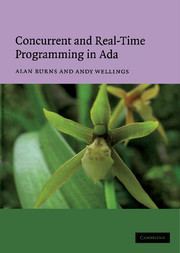Book contents
- Frontmatter
- Contents
- Preface
- 1 Introduction
- 2 The nature and uses of concurrent programming
- 3 Inter-process communication
- 4 Task types and objects
- 5 The rendezvous
- 6 The select statement and the rendezvous
- 7 Protected objects and data-oriented communication
- 8 Avoidance synchronisation and the requeue facility
- 9 Exceptions, abort and asynchronous transfer of control
- 10 Object-oriented programming and tasking
- 11 Concurrency utilities
- 12 Tasking and systems programming
- 13 Scheduling real-time systems – fixed priority dispatching
- 14 Scheduling real-time systems – other dispatching facilities
- 15 Timing events and execution-time control
- 16 Real-time utilities
- 17 Restrictions, metrics and the Ravenscar profile
- 18 Conclusion
- References
- Index
12 - Tasking and systems programming
Published online by Cambridge University Press: 10 December 2009
- Frontmatter
- Contents
- Preface
- 1 Introduction
- 2 The nature and uses of concurrent programming
- 3 Inter-process communication
- 4 Task types and objects
- 5 The rendezvous
- 6 The select statement and the rendezvous
- 7 Protected objects and data-oriented communication
- 8 Avoidance synchronisation and the requeue facility
- 9 Exceptions, abort and asynchronous transfer of control
- 10 Object-oriented programming and tasking
- 11 Concurrency utilities
- 12 Tasking and systems programming
- 13 Scheduling real-time systems – fixed priority dispatching
- 14 Scheduling real-time systems – other dispatching facilities
- 15 Timing events and execution-time control
- 16 Real-time utilities
- 17 Restrictions, metrics and the Ravenscar profile
- 18 Conclusion
- References
- Index
Summary
Ada is a high-level programming language; it provides abstract constructs that allow programs to be constructed easily and safely. However, it is recognised that one of the intended application areas for Ada is the production of embedded systems. Often these (and other) systems require the programmer to become more concerned with the implementation, and efficient manipulation, of these abstract program entities. Ada resolves this conflict in two ways:
by allowing the programmer to specify the representation of program abstractions on the underlying hardware, for example by specifying the layout of a record or the address of a variable; and
by having extra facilities in the Systems Programming Annex for interrupt handling, controlling access to shared variables, unique identification of tasks, task attributes and the notification of task termination. As with all Ada annexes, these features need not be supported by all compilers.
The areas that are of concern in this book are those which relate directly to the tasking model. These are:
device driving and interrupt handling – covered in this chapter;
access to shared variables – previously covered in Section 7.12
task identification – motivated in Section 4.4 and covered fully in this chapter;
task attributes – covered in this chapter;
task termination (notification thereof) – covered in Section 15.7.
Other relevant embedded systems issues such as access to intrinsic subprograms, control over storage pools and data streams, and the use of machine code inserts are not dealt with.
- Type
- Chapter
- Information
- Concurrent and Real-Time Programming in Ada , pp. 293 - 316Publisher: Cambridge University PressPrint publication year: 2007

